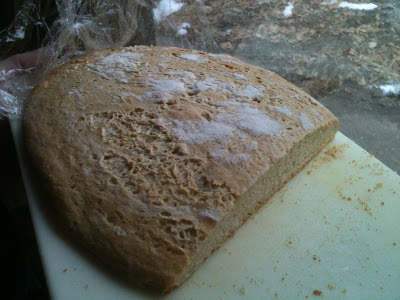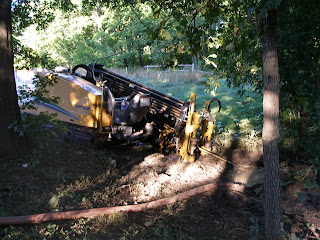Sustainable Agriculture
My definition of sustainable agriculture is somewhat divergent from the popular understanding. I am a Permaculture designer. I study Temperate Climate Polyculture Design and work with perennial systems that build self-renewing fertility in soils that host the anchor plants we harvest. To me, sustainable means self-sustaining, with few external resources or resources combined in a system of mutual support. Since entropy is prevalent in all things and change is constant, I believe it is not the thing that is sustainable but the system in which the things exists.
A forest is self-sustaining in a moderately consistent climate. The trees and plants cycle through, succession builds base resources and decomposition cycles the nutrients and organic material. It is sustainable unless a volcano or strip mine appears near by and disrupts the resource cycle. Within a given environment, anything is sustainable.
Sustainable agriculture yields a resource for human use without depleting the resources needed for the next yield or for future yields. Sustainable Agriculture increases the capacity of resource systems to buffer changes in weather and it builds the soil resource for plant and organisms, which make up the soil ecosystem. A sustainable system has few or no limiting factors. External inputs are limiting factors since they build a dependency (Dennis Keeney (1989), Sustainable Agriculture: Definitions and Concepts).
My broad area of concern in Sustainability is environmental. In Mazlow’s Hierarchy of Needs, the basest need is physiological. Life begins with food, water, and then shelter or safety. The environment creates the economics and the environment allows the social structure to exist. Only after the environment has been established and is viable for human use can the others appear. Civilizations have collapsed because they destroyed the local environment that supported the social structure.
The Maya, the Roman Empire, even the indigenous people in the southwestern United States salinated their lands beyond use. A story repeated over thousands of years. Their economies did not save them. Yet if an economy collapses or social order declines, people can return to the land and rebuild their society or economy. The land, the soil and the water, not to mention the bees, the fungi, and the macro wildlife, play a vital role silently in the darkness or on the soil creating the opportunity for human occupation.
My worldview is rather cynical of late. I hope for the best and feel that most parts of the world would be best left alone and to figure out their own resource issues. The peasants seem to get along fine without warlords. Skirmishes come and go on small scales relative to the immense scale of governmental intervention. The Green Revolution was co-opted by multinational corporations who farmed for profit rather than sustenance. Forcing small landholders off while moving big machinery on. Feeding the world would take more selfless acts by individuals or organizations like Heifer international that focus on self reliance not global dependence on limited resources, like phosphorus, that will soon be depleted.
My worldview comes from rural/suburbia and weeks of camping in wilderness areas. Harvesting edible plants with Native Americans. Eating my own tomatoes, potatoes and squash from a small garden that could feed many. It would seem feasible for everyone to at least contribute to growing some of his or her own food locally. Assuming the soil has not be depleted or contaminated. Douglass, Gordon. K,(1984), The Meaning of Sustainability, holds the baseline at feeding the world. I have been to farms in Iowa where they say they feed the world. It’s ironic, because the corn and the soybean are inedible and the majority of the yield is sold for processed foods. If you are living on corn syrup, it is possible, but I doubt the claim is true. I understand soft drinks and cows take the majority of the corn (Pollan, Michael, 2008, Omnivores Dilemma).
My view of sustainability in general shifts over time, but it applies to vast aspects of my life. Agricultural sustainability is focused on the long-term production of food and fiber, which is entrenched in tradition as well as capital investments based on mechanical and chemical regimes.
News Article
Mother Jones, March 2009
Spoiled: Organic and Local Is So 2008
By Paul Roberts
In this article, Paul Roberts explains the conflict of organic practices and traditional farming along with the return on investment of a world going organic. Much of his article gives examples of problems that face early adopters as well as long-range implications of a narrowly focused definition or organic or sustainable agriculture. He divides the participants into two camps. On one side the zealous organic consumers and the other side stodgy corporate farms, neither willing to find common ground. He proposes a hybrid organic, which uses smaller pesticide doses along with no till practices to reduce erosion and chemical loss.
Roberts makes broad statements concerning the resources needed for animal manures as fertilizer and the huge land masses needed to do so and yet compares a seven acre Japanese polyculture farm doing so to a 200 million dollar skyscraper green house. Giving little praise to the smallholding and taking more space to explain the questionable techno-fantasy. Roberts stops short of listing the total externalized cost comparison of the two, but an established and proven self sustained farm feeding 100 families for decades beats a 30-story farm that does not exist. It would seem much more could be gained studying the working system and its variations. With this however come the hybrid systems that could be devised with creative problem solving using the old and the new.
Roberts spends small space on Growing Power, a Milwaukee facility that promotes optimized farming practices in urban areas. Roberts then uses three times the space to talk of roof top gardens on supermarkets in San Francisco. The problem with the agro-architecture solution is computer-aided designers use, hardscape programs, materials and space that is extremely expensive and devise them to be climate controlled. The externalized cost is enormous and feeds the erroneous notion that technology and money will buy us out of our problems.
Building a community of discerning consumers will take more than space age renderings of techno-solutions. The true solutions will probably be mundane and simple. The base appeal must be to the consumer as partner in the production of the food, as in Community Supported Agriculture or local farmer’s markets. The consumer must appreciate the difference and perhaps sacrifice a bit of convenience for long-range sustainability.
Finally, Roberts equates sustainable agriculture with investments of high capital infusions, technology and markets to service. He removes the third world from access to sustainable practices for lack of all three resources above. On the contrary, the peasant farmers and small landholders growing rice or vegetables have been for the most part self sufficient and sustainable for generations. The large cities in these areas have the same dilemma as the USA, but are closer culturally to their heritage of farming and have sustained open-air markets to supply the city’s needs, supporting the outlying villages and farmers.
On a trip to an Iowa dairy of 3000 cows, the owner claimed they were more sustainable than the 60 small dairies it would take to produce their volume (Most of which went to Blue Bunny ice cream at a loss due to long term contracts). He said they used less space, fewer resources and were more efficient. For the most part, having 60 small farm dairies and the supporting infrastructure, schools, restaurants, churches, stores and social services might better serve mankind than another confinement dairy farm. I think the cows would also approve since the life of the overburdened confinement cow (18-36 months) is about a quarter of a small dairy’s cow, which can live 10-13 years.
Building a sustainable system is when all members are supported and not exploited. Each is allowed to be what they are. A cow can graze; a chicken can roost and use their natural lives to benefit mankind and each other.


Comments